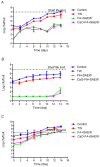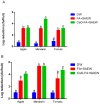Disinfection Efficacy of Slightly Acidic Electrolyzed Water Combined with Chemical Treatments on Fresh Fruits at the Industrial Scale
- PMID: 31615099
- PMCID: PMC6835452
- DOI: 10.3390/foods8100497
Disinfection Efficacy of Slightly Acidic Electrolyzed Water Combined with Chemical Treatments on Fresh Fruits at the Industrial Scale
Abstract
The objective of this study was to investigate the efficacy of slightly acidic electrolyzed water (SAEW) combined with fumaric acid (FA) and calcium oxide (CaO) treatment on the microbial disinfection of fresh fruits including apple, mandarin, and tomato at the industrial scale. The combined treatments can significantly (p < 0.05) reduce the population of natural microbiota from the fruit surfaces and the treated samples showed good sensory qualities during refrigeration storage. In addition, decontamination of inoculated foodborne pathogens (Escherichia coli O157:H7 and Listeria monocytogenes) was carried out in the laboratory, and the combined treatments resulted in a reduction ranging from 2.85 to 5.35 log CFU/fruit, CaO followed by SAEW+FA treatment that resulted in significantly higher reduction than for SAEW+FA treatment. The technology developed by this study has been used in a fresh fruit industry and has greatly improved the quality of the products. These findings suggest that the synergistic properties of the combination of SAEW, FA, and CaO could be used in the fresh fruit industry as an effective sanitizer.
Keywords: combined treatments; fruits storage; inactivation; slightly acidic electrolyzed water.
Conflict of interest statement
The authors declare no conflict of interest.
Figures






References
-
- Ohashi T.L., Foukaraki S., Corea D.S., Fereira M.D., Tery L. Influence of 1-methylcyclopropene on the biochemical response and ripening of ‘solo’ papayas. Rev. Bras. Frutic. 2016;38:14. doi: 10.1590/0100-29452016791. - DOI
LinkOut - more resources
Full Text Sources
Molecular Biology Databases

